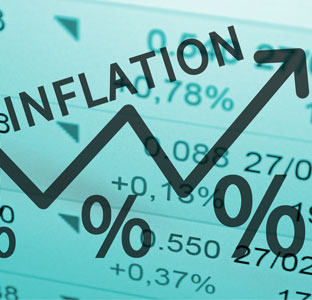What is inflation?
Inflation is a “sustained increase” in the general price level in the economy. Inflation means an increase in the cost of living because prices for goods and services rise. Inflation is the decline of purchasing power in a currency over time. The increase in the general level of prices, often expressed as the rate of inflation (as a percentage) means a unit of currency buys less than in the past.
Inflation is considered positive when consumer demand and consumption are increased –driving economic growth. When inflation is too high, it is not considered a good thing for the economy or individuals. Inflation will always decrease the value of money, unless interest rates are higher than inflation – the higher inflation is, the less chance for savers to obtain any real return (what is earned after accounting for inflation and taxes) on their money.
There are two types of inflation that cause an increase in the overall price level within an economy. Cost-push inflation is a rise in prices caused by a rise in the cost of production. For example, energy price increases result in the cost of producing and transporting to rise. Demand-pull inflation is a rise in prices caused by increased demand. Companies will increase prices due to a shortage of goods.
Hyperinflation, just to clarify, is generally considered to occur when inflation is increasing more than 1000%. Money loses value so fast that consumers do not want to use it as a medium of exchange. Examples of hyperinflation were Germany in the 1920s at 100 billion %, and Hungary in 1946 at 42,000 billion %.
Inflation in the U.S. has not reached 3.00% in more than 20 years. This is based on core CPI data (consumer price index less prices for food and energy = measures the change in the out-of-pocket expenditures of households). One of the most hotly-debated topics this year is whether inflation will return and what impact this may have on the economy and markets.
So, what is considered high inflation? The current thinking is 2.50% Core PCE (personal consumption expenditures = measures prices paid by consumers for goods and services except food and energy). This would be a 27-year high!
For now, short-term interest rates are anchored, or in other words, are not moving much if at all. This is not the case with longer-term interest rates. They have been moving up. The absolute low for the 10-year Treasury Note was 0.33% on March 9, 2020. The 10-year Treasury Note is now about 1.128%. In “bond-land” that is a big move.
What is this signaling? The reason interest rates move is EXPECTED nominal growth. The definition of nominal growth is real economic growth plus inflation.
Over the last 20 years the focus of interest rate movement has been expected economic expansion or contraction. Little or no movement has been due to inflation – it has been as if inflation has been deleted from the equation. The issue now becomes are interest rates moving due to expected nominal growth or future expected inflation? The out-of-consensus view is that interest rates are moving up due to the revival of inflationary expectations – this would pose a problem for risk assets.
We do not know, and neither does anyone else, what will transpire. In particular, the stock markets over the last several years, and even now with the expectation of more stimulus, have been moving up. Bond market participants right now are divided about expected growth and inflation. If all bond investors come to the same realization that inflation is the reason for rates moving up, that will most likely cause the Federal Reserve (FED) to change course. It may force them to pull back or stop bond purchases, and rethink keeping interest rates at the zero bound. If bond investors become one in thought, they will sell, and rates will go up. The shear size of the bond market can overwhelm the FEDs policies.
While we are always optimistic long-term, the uncertainty of our times, and the battle between FED liquidity versus the consequences of expected future inflation, warrants some cash reserves. The current fundamentals of the stock market on a historical basis are extremely overvalued to the most overvalued in history. The bond bull market of the last 39 years or so, may have ended in March of 2020. Even if inflation remains subdued, we believe that current elevated market fundamentals will afford us the opportunity to invest at better valuation levels.
We appreciate and thank you for the trust and confidence you have placed in Occam Capital® Management, LLC.

